The $60 CPU Question: AMD Athlon 200GE or Intel Pentium Gold G5400? A Review
by Ian Cutress on January 14, 2019 8:00 AM ESTCPU Performance: Office Tests
The Office test suite is designed to focus around more industry standard tests that focus on office workflows, system meetings, some synthetics, but we also bundle compiler performance in with this section. For users that have to evaluate hardware in general, these are usually the benchmarks that most consider.
All of our benchmark results can also be found in our benchmark engine, Bench.
PCMark 10: Industry Standard System Profiler
Futuremark, now known as UL, has developed benchmarks that have become industry standards for around two decades. The latest complete system test suite is PCMark 10, upgrading over PCMark 8 with updated tests and more OpenCL invested into use cases such as video streaming.
PCMark splits its scores into about 14 different areas, including application startup, web, spreadsheets, photo editing, rendering, video conferencing, and physics. We post all of these numbers in our benchmark database, Bench, however the key metric for the review is the overall score.

As an all-around test, one hopes that PCMark should be able to shine a light into this analysis. The end result is that PCMark says Intel should be ahead by around 8%.
Chromium Compile: Windows VC++ Compile of Chrome 56
A large number of AnandTech readers are software engineers, looking at how the hardware they use performs. While compiling a Linux kernel is ‘standard’ for the reviewers who often compile, our test is a little more varied – we are using the windows instructions to compile Chrome, specifically a Chrome 56 build from March 2017, as that was when we built the test. Google quite handily gives instructions on how to compile with Windows, along with a 400k file download for the repo.
In our test, using Google’s instructions, we use the MSVC compiler and ninja developer tools to manage the compile. As you may expect, the benchmark is variably threaded, with a mix of DRAM requirements that benefit from faster caches. Data procured in our test is the time taken for the compile, which we convert into compiles per day.
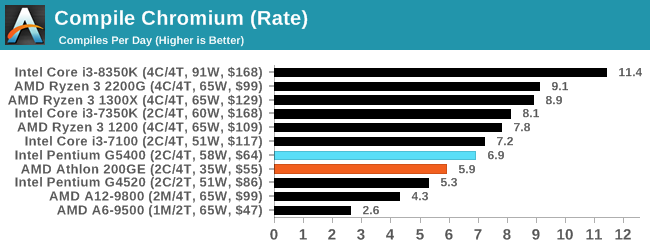
I like this Chromium test, given that it probes a lot of areas within a system. The Intel G5400 wins here again, scoring 6.9 compiles per day, compared to 5.9 for the AMD 200GE.
3DMark Physics: In-Game Physics Compute
Alongside PCMark is 3DMark, Futuremark’s (UL’s) gaming test suite. Each gaming tests consists of one or two GPU heavy scenes, along with a physics test that is indicative of when the test was written and the platform it is aimed at. The main overriding tests, in order of complexity, are Ice Storm, Cloud Gate, Sky Diver, Fire Strike, and Time Spy.
Some of the subtests offer variants, such as Ice Storm Unlimited, which is aimed at mobile platforms with an off-screen rendering, or Fire Strike Ultra which is aimed at high-end 4K systems with lots of the added features turned on. Time Spy also currently has an AVX-512 mode (which we may be using in the future).
For our tests, we report in Bench the results from every physics test, but for the sake of the review we keep it to the most demanding of each scene: Cloud Gate, Sky Diver, Fire Strike Ultra, and Time Spy.
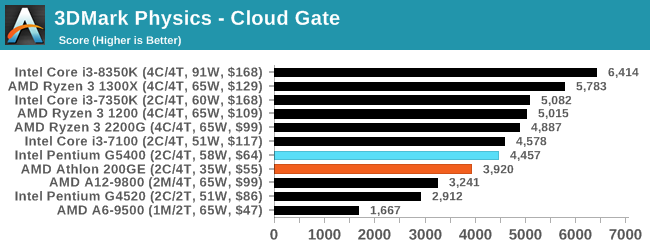
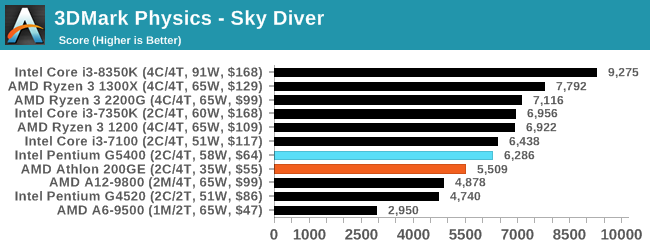
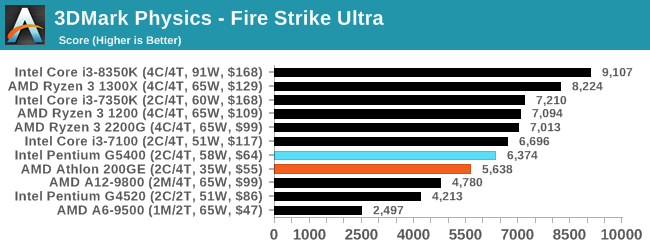
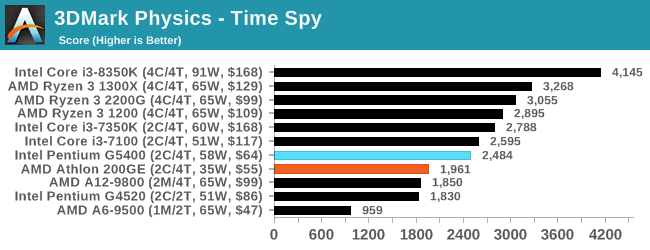
In all the tests except Time Spy, Intel takes an 11-12% lead over AMD, while in Time Spy that increases to 20%.
GeekBench4: Synthetics
A common tool for cross-platform testing between mobile, PC, and Mac, GeekBench 4 is an ultimate exercise in synthetic testing across a range of algorithms looking for peak throughput. Tests include encryption, compression, fast Fourier transform, memory operations, n-body physics, matrix operations, histogram manipulation, and HTML parsing.
I’m including this test due to popular demand, although the results do come across as overly synthetic, and a lot of users often put a lot of weight behind the test due to the fact that it is compiled across different platforms (although with different compilers).
We record the main subtest scores (Crypto, Integer, Floating Point, Memory) in our benchmark database, but for the review we post the overall single and multi-threaded results.
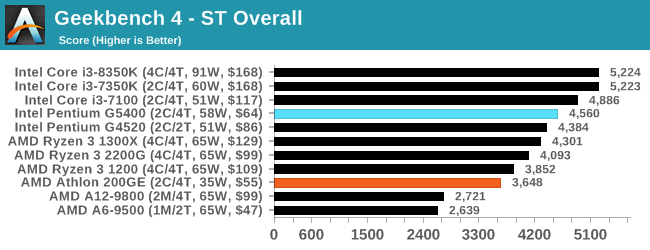
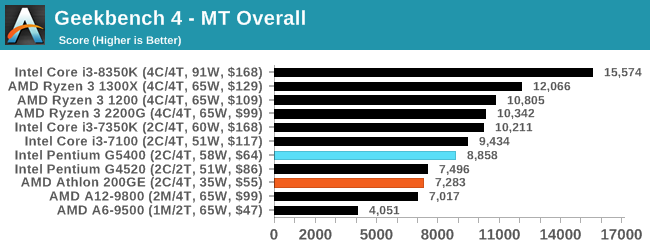










95 Comments
View All Comments
shabby - Tuesday, January 15, 2019 - link
Lol this chip hasn't been $60 for half a year, what was AT thinking writing this article? The intel bias is strong here.yannigr2 - Monday, January 14, 2019 - link
I stopped reading this article when I saw that the Pentium price is NOT based on the ACTUAL price of the processor in the market, but just some marketing/wishful thinking that Intel posts on it's site.Pity. I was expecting more from Anandtech.
mobutu - Monday, January 14, 2019 - link
"In gaming with a discrete graphics card, for example, if you've invested in something like the GTX 1080..."so we're talking about the absolute cheapest of the cheap build but all of the sudden "you invested in a GTX 1080" ?
megaLOL wtf is this
sing_electric - Monday, January 14, 2019 - link
Yeah, that sentence is weird (though I guess, if you have $400 now, you can get a working system with a very solid PSU and the rest of the specs listed here, and if you have money later, plop in a dGPU you actually want, and after that, get the CPU you actually want), but the reason to use a GTX 1080 in the test is that you can be more or less guaranteed that none of the scores you saw were GPU-bound, so you're getting an idea of CPU performance. Otherwise, whatever GPU they chose (1030? 1050? RX 550/560?) would sometimes be the bottleneck, meaning the charts wouldn't tell you anything comparing the two CPUs.drexnx - Monday, January 14, 2019 - link
I think the obvious conclusion from this article is skip both and buy the R3 2200Gshabby - Monday, January 14, 2019 - link
That cpu is still cheaper than the g5400 which costs $130 even at Newegg. Where did Ian get the price of the g5400? It makes this article worthless.sing_electric - Monday, January 14, 2019 - link
Right, I think these processors are aimed more at OEMs trying to hit a price point. The cheapest I can do a reasonable system build around these is $305, in which case, the extra cash to go for the R3 seems like a no-brainer.Even if its an upgrade vs. a new build, you're looking at ~$180 minimum ($60 for the CPU, $60 for the motherboard, since there is basically no way you already AM4/LGA1151 system and look at this as an "upgrade," and that means you probably need new RAM since chances are you're coming from DDR3), in which case, why not spend the extra $30-40 for a significant step up in processor (and, in the case of AMD, one that officially supports overclocking).
piasabird - Monday, January 14, 2019 - link
I would have thrown in the Intel i3 8100 quad core which is selling for $118 on Newegg. It is close to the same price as the i3 7100. If you purchase it at a Micro Center you might get $30 off on a motherboard combo.drzzz - Monday, January 14, 2019 - link
WTF Ian? As of this post the Intel is 183$ follow the link in the article and the AMD is 60$. This is not a even close to comparing 60$ parts. Seriously how did this get by the editors?shabby - Monday, January 14, 2019 - link
The editors were intel...